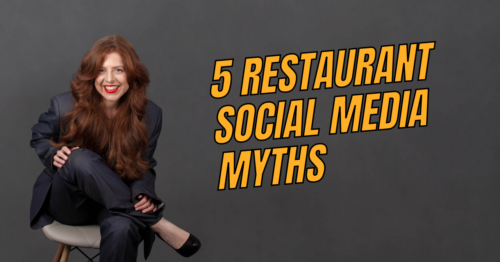Trends in Restaurant Promotion for 2024
In this article, we will explore the most effective strategies in 2024 to attract new guests, enhance customer communication, stand out from competitors, and make your establishment a success.
What is the main trend? It’s a game-changer that will shape every aspect of your restaurant’s marketing: creating a space your customers genuinely want to be in.
Now, this might seem straightforward, like it’s all about interior design and creating a fancy ambiance. But it goes beyond that. It’s about the feeling customers get when they step into your establishment.
Shift your focus from the restaurant itself to the customer experience it offers.
Every trend we’ll explore today circles back to this key message for the year: create more than just a place to eat out.
To implement this in your restaurant you need to create an effective marketing system. If you have no idea where to start building it, I have great news for you. I’ve created a one-page Cheat Sheet on “How to Build a Restaurant Marketing System” that will provide you with a clear understanding of what a marketing system in a restaurant is, what elements it consists of, and where to start building it. You can get your copy absolutely FREE right now
TREND #1
Building trust and creating relationships between your restaurant and your guests
Keep in mind that it’s not about guests in general but about connecting with each specific guest. People are becoming more selective in choosing where to spend their money, and a big factor in this decision is the sense of safety they feel when interacting with a restaurant.
In the past, competition was all about the product or function—boasting the best steaks or the fastest pizza delivery in town. Now, there’s a new player in town: trust in a particular restaurant. Guests are subconsciously asking, “Can I trust this place?”
Trust might seem irrational at first, but it’s built from many bricks. In terms of promotion, trust is primarily established through your restaurant’s content.
What should you focus on in your content?
- Showcase the kitchen, from daily operations to supplier selection, emphasizing the importance of working with local producers.
- Feature your employees’ work, including live broadcasts or videos from training sessions, working moments at planning meetings, and birthday greetings.
- Narrate the story behind your establishment’s design, highlighting even small changes in the hall for special occasions.
- Tell customers more about your employees. Share their stories of why they chose to work in your restaurant.
- Offer a master class from your chef.
- Publish a story about the owner, detailing who they are, why they entered the restaurant business, why they opened this particular restaurant, their hobbies, and values.
- Conduct interviews with the owner, general manager, and chef.
The main idea is to showcase various aspects of your restaurant’s life in your posts, creating a three-dimensional perception of the establishment. When you only display your menu and promotions, the perception of the restaurant becomes flat and one-sided. By presenting small pieces from different aspects of your restaurant’s life, you create this three-dimensional perception of the establishment. Over time, people will have a feeling they know everything about your restaurant. And what is understandable inspires more confidence.
TREND #2
Building a community
In the past, building a community was an essential aspect of a restaurant, providing a significant advantage to those who succeeded in doing so.
Now, community building stands as one of the fundamental factors for a restaurant’s success.
With competition intensifying in every segment, standing out becomes imperative. While creating new and exciting dishes, events, or some provocative actions can be tempting, there are two potential pitfalls. First, sustaining such endeavors, in the long run, becomes challenging, leading to actions and events losing their effectiveness. Second, continual bright and possibly provocative activities may eventually lead to diminishing interest as they become predictable. Moreover, there’s a risk of making mistakes that could potentially scare away guests, a scenario I’ve seen many times in different restaurants.
True community building goes beyond superficial activities. It involves establishing a deeper level of communication with guests, where they view your restaurant as an integral part of their lives. It’s about creating an environment where guests feel at home, embracing the experiences they’ve always yearned for.
There are many ways to implement community building. Today we’ll explore three strategies.
Strategy 1. Hosting Regular Events
Regular events, held at a specific frequency, for example once a week, are easy to organize with minimal or zero budget. The primary goals include attracting customers during off-peak hours and positioning the restaurant in a particular way. Examples include foreign language learning groups, literary clubs, yoga meetings, healthy food clubs, and professional clubs like marketing, business, management, or copywriting. The idea is to create friendly gatherings that guests eagerly anticipate and perceive as part of their routine. When planning regular events, consider your potential customers’ preferences and align the events with your restaurant’s theme.
Strategy 2. Becoming an Integral Part of the Local Community
Act as a platform for creativity by hosting exhibitions, musical evenings, or stand-up events. This showcases your restaurant as more than just a dining establishment; it demonstrates a commitment to supporting the local community and investing in art.
Strategy 3. Involving Guests in the Restaurant’s Work
Leverage social networks to engage with customers. Conduct polls, ask customers’ opinions on new menu items, and showcase behind-the-scenes, for example, how you create a new dish. Instead of hiring models for advertisements, organize a photo contest with simple conditions, like taking a photo in your themed photo zone. The winner receives a professional photo shoot in the restaurant. You can use the photos and videos from this photo shoot for your advertising and social media content. This approach conveys that your restaurant is a place of limitless possibilities, where everyone can become whoever they want, even a model featured in advertising.
“I’d like to mention that if you’re interested in exploring more restaurant marketing trends for 2024, you can check out my article on Modern Restaurant Management titled “From Consumption to Connection: Restaurant Promotion Trends for 2024.”
TREND #3
Creating Stories
Storytelling is one of the most effective ways to evoke emotions and ensure that customers remember your content. In today’s world, where people are overloaded with information and quickly lose focus, leveraging storytelling becomes essential for your restaurant’s content. Instead of merely announcing events or promotions, incorporating storytelling can captivate your audience.
Creating stories doesn’t have to be as complex as it might initially seem; it’s a skill you can easily master.
Let’s delve into an example to illustrate how you can seamlessly integrate storytelling into your everyday content.
Imagine hosting a stand-up show in your establishment on Saturday. Rather than just sharing the event details on social media, use it as an opportunity to craft a compelling narrative. Instagram Stories can be an excellent platform for this.
- First Story: Share the significance of a good mood in people’s lives and why it matters.
- Second Story: Explain your decision to organize a stand-up show in your restaurant this Saturday to enhance the community’s well-being.
- Third Story: Engage with your audience by asking if they like the idea and encourage interaction.
- Fourth Story: Announce that you’ve invited young artists from your city to participate in the event.
- Fifth Story: Express your desire for people to get to know these artists better.
- In subsequent stories, post videos featuring these artists, where they introduce themselves and explain why stand-up is an essential part of their lives. This establishes a personal connection between the viewers, artists, and your establishment.
Start this storytelling process on Monday if your event is on Saturday. Throughout the week, share details about the artists.
On Saturday, create a series of stories showcasing the event’s preparation details, the stage decoration, the artists’ arrival, and a short video capturing their excitement about the upcoming show. Highlight how people are gathering in the restaurant and introduce new dishes and cocktails available during the event.
Engage customers by creating polls or asking simple questions.
During the event, post short live videos.
After the event, share short videos where customers and artists express their impressions. Post these videos on Sunday, creating a closed communication field: you announced the event, explained why you held it, showed preparation details, shared the event experience, and captured people’s impressions.
This approach not only enhances engagement and interest but also provides a behind-the-scenes look, communicates your restaurant’s values, and shapes the right perception in customers’ minds.
TREND #4
Creating an Eventful Experience
In today’s landscape, a restaurant faces many different competitors, ranging from other dining establishments to options like delivery, street food, or home cooking. It’s not just about distinguishing one restaurant from another, showcasing a unique selling proposition, or managing an engaging social media presence.
The focus here isn’t on transforming every restaurant visit into an event, but rather on providing compelling reasons for customers to choose your restaurant.
In the current environment, people are overwhelmed with information. They don’t seek further complexities to understand the nuances of each restaurant, its offerings, or the reasons they might enjoy dining there. Instead, they often opt for what is closer, simpler, clearer, or what offers additional value beyond a standard restaurant visit.
So, how can you implement this?
Take a look at upcoming events and integrate them into your restaurant’s marketing activities. Whether it’s Valentine’s Day, the beginning of spring, Friends’ Day, Chocolate Day, Coffee Day, or your restaurant’s birthday, leverage these occasions to create events and intertwine promotional offers into your marketing strategy.
The benefits of adopting this approach are as follows:
- Decision-Making Support: It helps guests in choosing your restaurant by providing something beyond a routine dinner.
- Perception Formation: It establishes a certain perception of your restaurant as a place where there is always a celebration.
- Word of Mouth and User-Generated Content Increase: It serves as the foundation for word-of-mouth marketing and encourages the creation of user-generated content.
TREND #5
Authenticity: Embracing Maximum Naturalness
In the era of artificial intelligence development, there is a growing demand for authenticity and naturalness. People are tired of manipulated, filtered photos that bear little resemblance to reality. This trend, observed last year, continues to gain momentum. Importantly, this desire for authenticity extends beyond personal profiles—it’s a significant aspect for businesses as well.
People crave a genuine depiction of products and real-life situations, not staged images. However, this doesn’t imply avoiding photo enhancement altogether; rather, it suggests doing it wisely.
Beautiful photos and videos are essential in maintaining your restaurant’s social media presence.
The goal is to provide guests with an immersive experience, enabling them to envision themselves in your establishment.
They should be able to assess the ambiance and decide how comfortable they would feel there. To achieve this, high-quality photographs and videos are crucial. While social media demands excellent quality, authenticity remains paramount.
Consider this: many restaurants now engage food photographers to capture their entire menu or specific items. However, often these images bear little resemblance to the actual dishes. The discrepancy between the photograph and reality can create dissonance, leading to unmet expectations and potential disappointment. It’s not necessarily that the dish is of poor quality; it’s simply different from what the guest envisioned.
This is why I believe the “naturalness” trend is particularly beneficial for the restaurant industry. The more truth you convey, the better your audience will respond. There’s no need to pretend to be something you’re not. It is always better just to be yourself. I hope these trends will be helpful for your restaurant’s promotion, and I encourage you to incorporate at least some of them into your marketing strategy.





